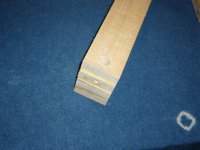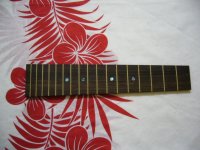UkeforJC
Well-known member
Dear all, after about four months, I finally almost finish my #4.
I hope you won't mind reading my long post again.
I would love to hear everyone's advice and feedback and learn from all of you. So, if you see something that I did is wrong, please let me know.
This ukulele is a concert uke. I follow the Hana lima plan.
Top: bear claw sitka spruce
Back/sides: zebrawood
fretboard and bridge: East Indian rosewood.
Neck: sitka spruce
I mainly used hand tools, since I am only making the uke on my dinning table in my small apartment.

This is the zebrawood back and sides that I got.

I used a simple shooting board and a low angle jack plane to shoot the edge for joining the back.

I used the tape methods to join the back plates. Quite simple...and I haven't run into any trouble yet.

The back is joined and the other board is the bear claw spruce.

Planing down the spruce down to about 2 mm.
I hope you won't mind reading my long post again.
I would love to hear everyone's advice and feedback and learn from all of you. So, if you see something that I did is wrong, please let me know.
This ukulele is a concert uke. I follow the Hana lima plan.
Top: bear claw sitka spruce
Back/sides: zebrawood
fretboard and bridge: East Indian rosewood.
Neck: sitka spruce
I mainly used hand tools, since I am only making the uke on my dinning table in my small apartment.

This is the zebrawood back and sides that I got.

I used a simple shooting board and a low angle jack plane to shoot the edge for joining the back.

I used the tape methods to join the back plates. Quite simple...and I haven't run into any trouble yet.

The back is joined and the other board is the bear claw spruce.

Planing down the spruce down to about 2 mm.







































